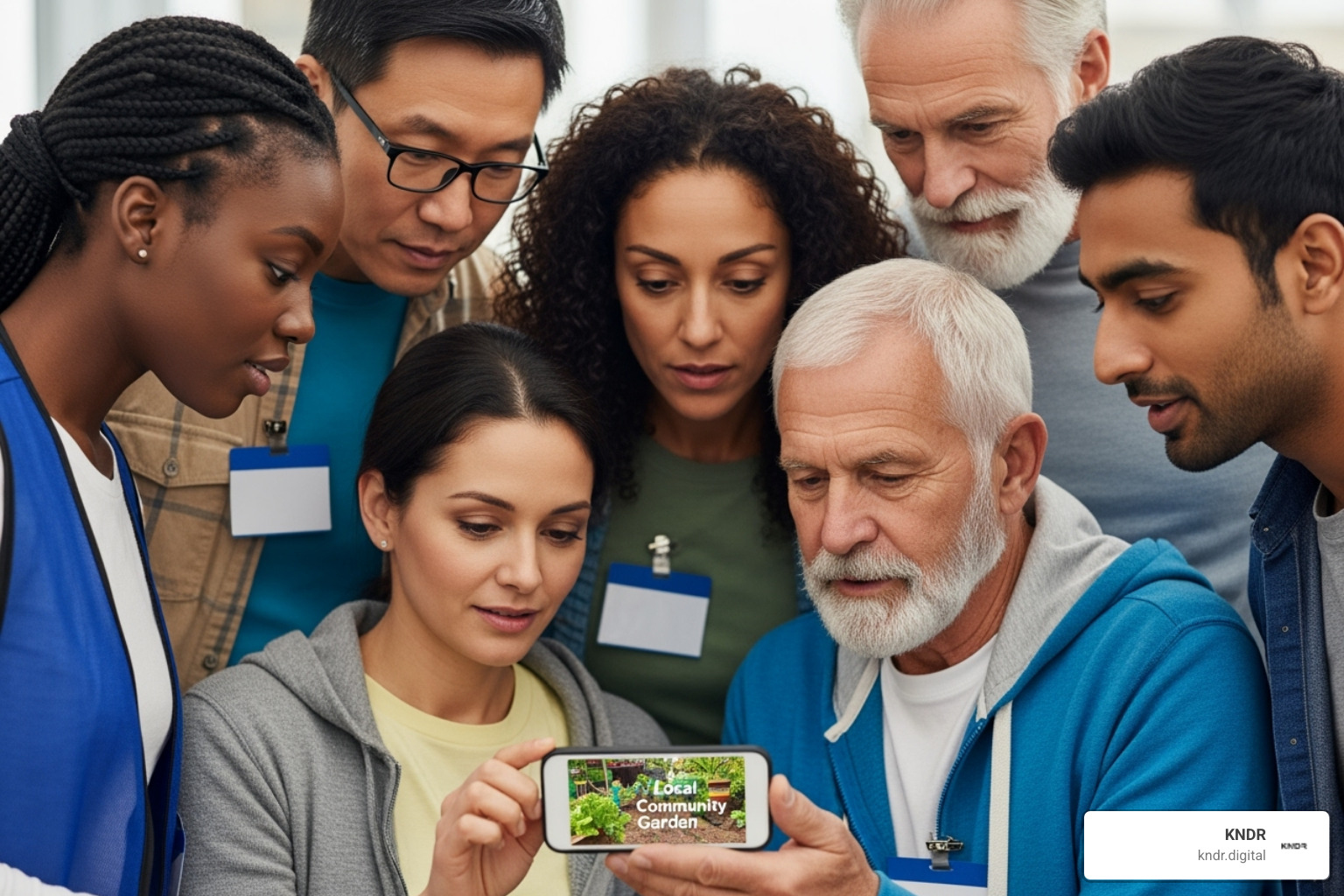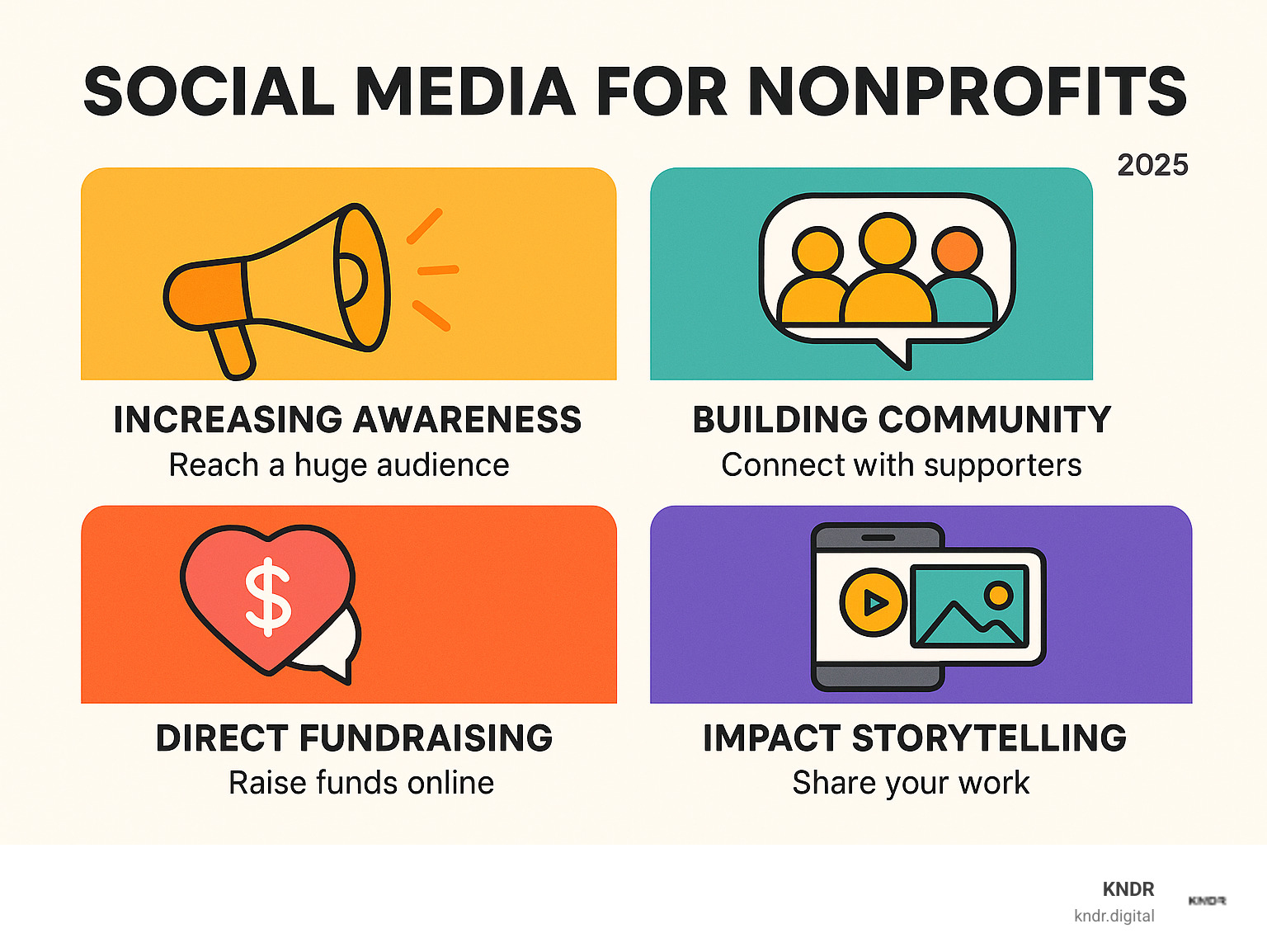Beyond Likes: A Nonprofit's Guide to Social Media Success

Why Social Media is Essential for Nonprofits
The primary benefits of social media for nonprofits include:
- Increasing Awareness: Reach a huge audience, making your mission known worldwide.
- Building Community: Connect with supporters, volunteers, and beneficiaries.
- Driving Engagement: Spark conversations and encourage active participation in your cause.
- Boosting Fundraising: Facilitate donations and mobilize support directly through platforms.
- Showcasing Impact: Share powerful stories of your work and its real-world results.
With nearly 4 billion users, social media is essential for making an impact. It's where people engage with organizations like yours—in fact, 55% of people who interact with nonprofits on social media take action, and 59% of those donate. Effective social media use is no longer a nice-to-have; it's a necessity.
I'm Mahir Iskender, and I've spent my career helping mission-driven organizations scale with smart technology. My expertise in social media for nonprofits helps organizations rethink donor engagement, streamline operations, and drive change.

Handy social media for nonprofits terms:
- digital fundraising for charities
- how to automate marketing for nonprofits
- best ai tools for nonprofits
Why Social Media is a Game-Changer for Nonprofits
Social media is a game-changer for nonprofits, changing how you connect, grow, and achieve your mission. It's your biggest megaphone for building brand awareness, fostering trust, expanding your reach, promoting events, and driving real action.
A whopping 55% of people who engage with nonprofits on social media go on to take action, and a significant number of them donate. This isn't about collecting 'likes'; it's about turning casual interest into tangible support for your cause.
More info about Charity Digital Marketing
Increase Your Mission's Visibility
Social media for nonprofits is the ultimate stage for storytelling. Your mission is about lives changed, so share compelling, human-centric content like powerful photos, heartfelt testimonials, and behind-the-scenes glimpses to reach new audiences. Think of it as a digital billboard broadcasting your impact stories. Pro tip: video is a superstar. Videos on Facebook can get 135% more organic reach than static images, helping you paint a vivid picture of the difference you're making.

Foster a Thriving Community
Social media for nonprofits isn't just for broadcasting; it's for building a warm, thriving community. Think of it as a two-way street where you can interact directly with your audience. This allows you to gather valuable supporter feedback, boost volunteer engagement, and build genuine loyalty.
Every time you respond to a comment, ask a question, or re-share content from your supporters, you're nurturing relationships. This continuous interaction helps create an engaged, active, and loyal online community that’s eager to champion your cause.
More info about Nonprofit Donor Engagement
Drive Donations and Support
This is where social media for nonprofits truly shines: driving donations. Today's platforms offer seamless online fundraising tools, making donor acquisition more straightforward than ever.
Consider this: 18% of donors worldwide have given through social media fundraising tools. These platforms allow you to place clear, compelling calls-to-action right where your audience is. Whether it’s a 'Donate' button, a powerful campaign, or a moving story, social media streamlines the journey from awareness to becoming a generous donor.
More info about Boosting Nonprofit Donations
Building Your Winning Social Media Strategy
A powerful social media for nonprofits strategy starts with SMART goals (Specific, Measurable, Attainable, Relevant, Time-bound), like increasing website traffic by 30% or recruiting 50 new volunteers. Next, understand your target audience: who are they and where do they spend time online? A homeless shelter might focus on Facebook, while an environmental group targets Instagram or TikTok. Resource allocation is also crucial. Even without an ad budget, you're investing time and staff energy. A well-planned content calendar helps you stay organized, consistent, and strategic.
More info about Digital Marketing Strategy for Fundraising
Choosing the right platforms for your social media for nonprofits strategy
You don't need to be everywhere. It's better to excel on two platforms where your audience is active than to spread yourself thin across five. Each platform has unique strengths.
| Platform | Key Demographics | Best For | Content Type | Fundraising Tools |
|---|---|---|---|---|
| 25-35 years old (primary), broad reach. 62% are millennials/Gen Z. | Broad awareness, community building, direct fundraising, events. | Photos, videos (especially Live), links, text posts. | Donation buttons, peer-to-peer fundraisers, Stars. | |
| 18-34 years old (62% of users), visual focus. | Visual storytelling, showcasing impact, influencer partnerships, younger audience engagement. | High-quality photos, short videos (Reels), Stories. | Donation stickers in Stories, shopping tags. | |
| 46-55 years old (primary), professionals. | Professional networking, volunteer recruitment, corporate partnerships, thought leadership. | Articles, professional updates, industry news, career opportunities. | Direct messaging for outreach, some integrated donation features. | |
| TikTok | 10-19 years old (biggest audience), short-form video. | Reaching Gen Z, viral content, creative storytelling, brand awareness. | Short, trending videos, challenges, authentic glimpses. | Creator funds, some direct donation links (less mature for nonprofits). |
| X (formerly Twitter) | 18-34 years old (58% of users), real-time news. | Real-time updates, advocacy, breaking news, direct engagement. | Short text, images, GIFs, short videos, links. | Less direct, relies on linked donation pages. |

Facebook is the heavyweight, with nearly 3 billion users and 93% of nonprofits present. It's ideal for community building and has robust, built-in fundraising tools.
Instagram shines with compelling visuals. If your work creates emotional or inspiring images, this platform is powerful. About 85% of nonprofits use it for good reason.
LinkedIn is excellent for corporate partnerships, volunteer recruitment, and reaching professional donors. In fact, 42% of US donors research nonprofits on LinkedIn.
The key is matching your mission and audience to the right platform.
Developing a Clear and Measurable Plan
Once you've picked your platforms, define success with Key Performance Indicators (KPIs). Focus on metrics that matter: engagement rate, reach, website clicks, and conversion rates (how many people donate or sign up).
Nonprofits see different engagement rates across platforms: Facebook averages 0.046%, Instagram hits 0.623%, and LinkedIn soars to 1.91%. These benchmarks help you set realistic expectations.
Your strategy needs content pillars—the main themes you'll consistently cover, like impact stories, behind-the-scenes moments, and calls-to-action. This keeps your content focused.
Posting frequency matters, but quality trumps quantity. Most nonprofits post about 5.5 times per week on Facebook, but three amazing posts are better than seven mediocre ones.
Finally, establish voice and tone guidelines. Your nonprofit's personality should shine through consistently. Authenticity resonates more than trying to sound impressive.
More info about Charity Campaign Strategy
Creating Content That Connects and Converts
Content is the heart of your social media for nonprofits strategy. The most effective content is authentic, uses powerful visual storytelling, and incorporates user-generated content from your supporters. Create content that resonates by showing the real-world impact of your mission and inviting people to become part of it.
More info about Digital Fundraising Best Practices
Best practices for creating content for social media for nonprofits
Humans are visual, so use high-quality visuals and compelling videos. Videos on Facebook get about 135% more organic reach than a static image. Showcase a short, impactful video or a live stream taking your audience behind the scenes. These visuals bring your mission to life.
Pair great visuals with compelling captions. Use them to tell a story, share information, and include a clear call to action and relevant hashtags. Also, share behind-the-scenes content to show the human side of your organization—your staff, volunteers, or processes. This builds incredible trust.
A secret weapon is user-generated content (UGC). Encourage supporters to share their own stories and photos related to your mission. Re-sharing their content provides fresh material and makes your supporters feel valued. For example, the American Cancer Society sees fantastic engagement by reposting stories from cancer survivors.

How to Effectively Interact with Your Audience
Social media for nonprofits is a conversation, not a monologue. To build a thriving community, you must actively engage. Prioritize responding to comments and messages promptly and authentically to show you're listening.
Don't be shy about asking questions to spark conversation. Pose open-ended questions or fun "fill-in-the-blank" posts. You can also run polls and quizzes to gather feedback and boost engagement.
Finally, host live Q&A sessions with your founder, a beneficiary, or an expert. Live sessions on platforms like Facebook Live or Instagram Live are incredibly engaging. A person will watch a Facebook Live video three times longer than the same pre-recorded content, making it a powerful way to connect in real-time.
More info about Donor Relationship Management
The Ultimate Guide to social media for nonprofits: Fundraising and Engagement
Beyond awareness and community, social media for nonprofits is crucial for driving donations and deepening donor engagement. It's about making a compelling case for support, simplifying the act of giving, and celebrating your donors. Key tactics include using platform donation features, launching peer-to-peer campaigns, running targeted ads, and influencer outreach.
More info about Digital Donor Acquisition
Leveraging Platform-Specific Fundraising Tools
Many social media platforms offer built-in features that streamline donations, making it easier for supporters to contribute directly. For example, platforms provide donation buttons or tools for supporters to set up their own fundraisers. A significant portion of fundraising revenue comes from these peer-to-peer efforts, like birthday fundraisers. Many donors have already used these tools and plan to do so again. Additionally, platforms like LinkedIn are great for exploring corporate partnership opportunities that can lead to matching gifts or sponsorships.
When launching a social media fundraiser, follow these key steps. First, define a clear, compelling goal. Next, craft a powerful narrative explaining why the fundraiser matters. Then, integrate KNDR's recommended donation tools or strategies to make giving easy. Promote your fundraiser across all channels—website, email, and other social platforms. Empower peer-to-peer fundraisers by encouraging supporters to create their own campaigns; thanking them on their pages can help them raise 35% more! Finally, provide regular updates on your progress and thank donors promptly and publicly.
Using Paid Ads to Amplify Your Message
While organic reach is great, paid social media advertising is essential for social media for nonprofits to cut through the noise. More than half of nonprofits now use social media advertising.
Paid ads offer incredible precision. You can target donors based on demographics, interests, and online behaviors, ensuring your message reaches the right people. You can also A/B test creative—different ad versions, headlines, and calls-to-action—to see what resonates and maximize your budget.
When budgeting for ads, even a modest amount can make a difference. It's about being smart with your spend. Carefully track your return on ad spend (ROAS) to see how much you're getting back for every dollar invested. While average ROAS varies, strategic targeting and compelling ads can lead to much better outcomes. Some platforms offer significantly lower costs per lead and donation, which helps you make smart decisions about where to invest your advertising dollars.
More info about AI-Driven Fundraising
Measuring, Refining, and Protecting Your Mission
To succeed with social media for nonprofits, you can't just post and hope. You must constantly measure performance, adjust your strategy based on data, and establish clear policies to protect your organization's reputation. It's about steering your efforts with purpose.
More info about Data-Driven Fundraising
Key Metrics to Track for Success
Measuring success is more than counting likes. Focus on metrics that show if your efforts are helping your mission.
Engagement Rate tells you what percentage of your audience interacts with your content. A high rate means your content is resonating. Average rates vary by platform: Facebook (0.046%), Instagram (0.623%), LinkedIn (1.91%), and TikTok (up to 7.5%).
Reach is the number of unique people who saw your content, showing how far your message is spreading. Also, watch Website Clicks to see how many people click from social media to your site—vital for driving traffic to donation pages.
Conversion Rate is the percentage of visitors who complete an action, like donating or signing up. For paid campaigns, track Cost Per Donation (CPD) and Return on Ad Spend (ROAS) to measure fundraising efficiency.
Use platform insights and Google Analytics to understand your followers, their active times, and their content preferences. This data is a goldmine for refining your strategy.
More info about Nonprofit Fundraising ROI
Creating an Essential Social Media Policy
A clear social media policy is crucial. It protects your reputation, ensures a consistent message, and guides your team's online behavior.
Brand Guidelines define your brand's look and sound, unifying your voice. Employee Conduct rules set expectations for staff on official and personal accounts, covering confidentiality and appropriate behavior.
A Crisis Communication Plan is a must-have strategy for responding to negative comments or criticism. This ensures you can react quickly and speak with one voice. Training your staff on these policies is a key step in being prepared and proactive.
Addressing social media concerns at your nonprofit
Common Myths and Misconceptions
Let's bust some common myths about social media for nonprofits.
Myth: "Social media is free." While accounts are free, effective social media requires a significant investment of time, staff resources, and often, an ad budget to see real results.
Myth: "You need to be on every platform." It's smarter to excel on one or two platforms where your audience is active. Juggling too many platforms leads to weak efforts.
Myth: "It's only for young people." While TikTok skews younger, Facebook and LinkedIn have huge numbers of older users. Your audience is on social media; you just need to find where.
Myth: "My millennial nephew can handle our social media." Effective social media management requires strategic thinking, marketing know-how, and consistent effort. It's a professional role, not a task to hand off lightly.
Frequently Asked Questions about Social Media for Nonprofits
How much time should a nonprofit dedicate to social media?
The ideal time commitment for social media for nonprofits depends on your size, goals, and resources. While many nonprofits spend two hours or less per week, this often isn't enough for meaningful engagement. Focus on quality over quantity and be realistic about what you can sustain. It's better to post compelling content twice a week consistently than to post daily and burn out.
Set clear goals (donations, volunteers, awareness) to guide your time allocation. A small nonprofit might dedicate 3-5 hours per week, while larger ones may have dedicated staff. Use content scheduling tools and AI to batch content creation and make your time more efficient.
More info about How to Automate Marketing for Nonprofits
What's the single most important thing for social media success?
If I had to choose one thing, it would be authenticity combined with compelling storytelling. Your audience wants to feel connected to why you do what you do and see the real impact of their support.
People scroll through hundreds of posts daily. What makes them stop are the human stories and genuine moments behind your mission. Sharing a volunteer's first day or how a donation changed a life creates an authentic connection that moves people from observers to supporters.
While consistency and audience understanding are crucial, it's the authentic narrative that cuts through the noise and inspires action. Social media is about building relationships, not just broadcasting messages.
Can a small nonprofit with no budget still succeed on social media?
Absolutely! While paid ads amplify reach, some of the most engaging content comes from organizations with tiny budgets but big hearts.
The secret is focusing your energy strategically. Choose one platform where your audience spends time and become excellent there. Master its features and build real relationships.
User-generated content is your best friend on a tight budget. Encourage supporters to share their stories and photos. This provides authentic content that resonates deeply and costs nothing but encouragement and recognition.
Creative storytelling doesn't require expensive equipment. A smartphone photo paired with a powerful personal story can be incredibly compelling. Think of a food bank sharing before-and-after photos of a community garden or a literacy program showing handwritten thank-you notes.
The key is active engagement. Respond to comments, ask questions, and connect with people. This builds a loyal community that shares your content organically, expanding your reach without spending a dime. Also, take advantage of free tools like Canva (which offers nonprofit discounts) and the analytics built into each platform.
Success isn't about your budget; it's about your strategy, consistency, and genuine connection.
Conclusion
Your journey with social media for nonprofits is just beginning. Use this guide as your roadmap to transform how your organization engages supporters, turning followers into donors and champions for your cause. Success requires a strategic approach where every post serves a purpose.
Continuous improvement is your secret weapon. The most successful nonprofits pay attention to their data, learn what resonates, and adjust their strategy accordingly. Tracking engagement, conversions, and other key metrics sets you up for long-term success.
Social media policies are your safety net, and don't fall for common myths. The data is clear: data-driven fundraising delivers better results. Knowing that videos get more reach or that thanking fundraisers boosts donations is knowledge you can put into action.
To implement these advanced strategies and guarantee fundraising results, see how KNDR's AI-powered systems can transform your digital outreach: https://www.kndr.digital


